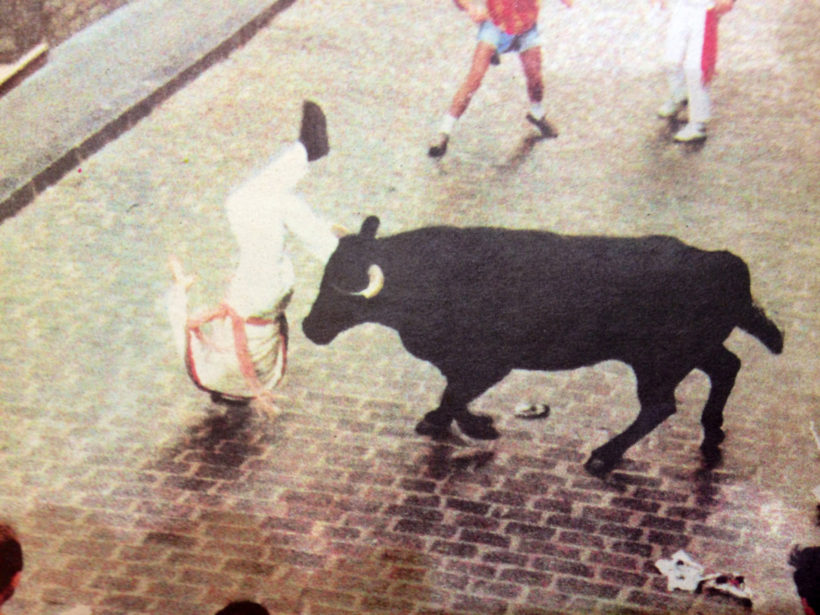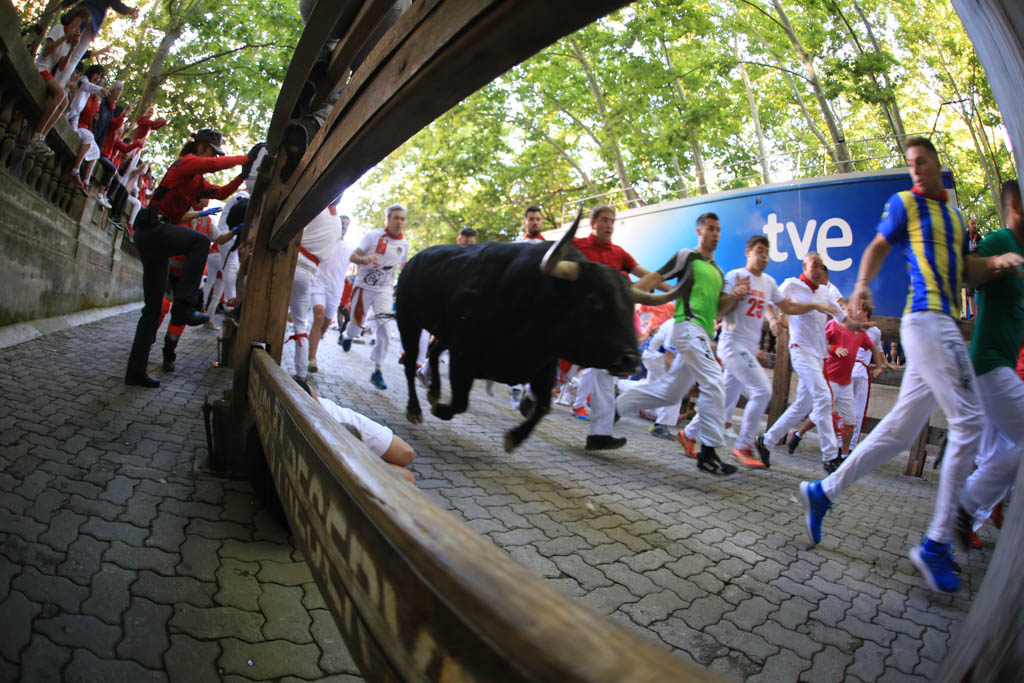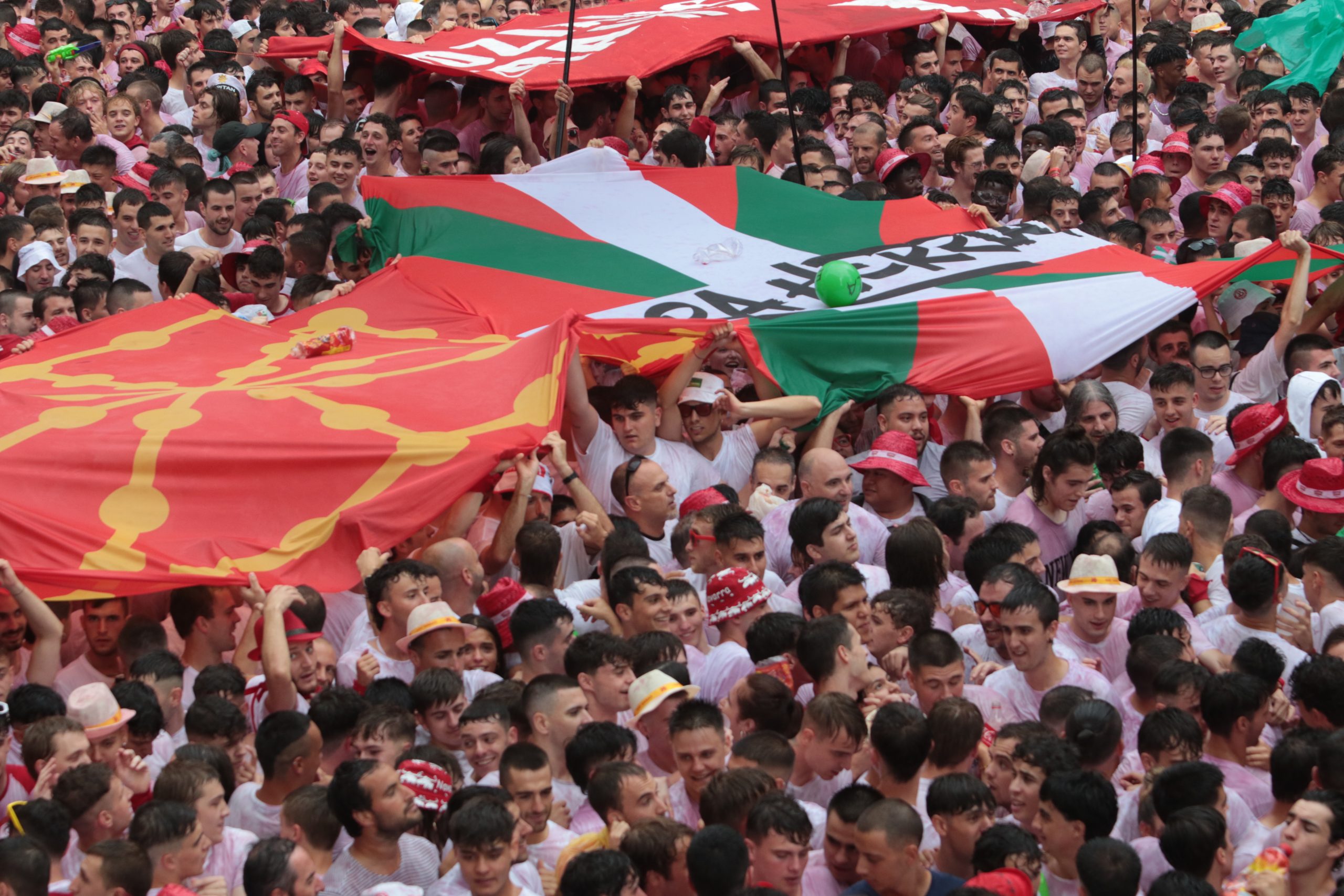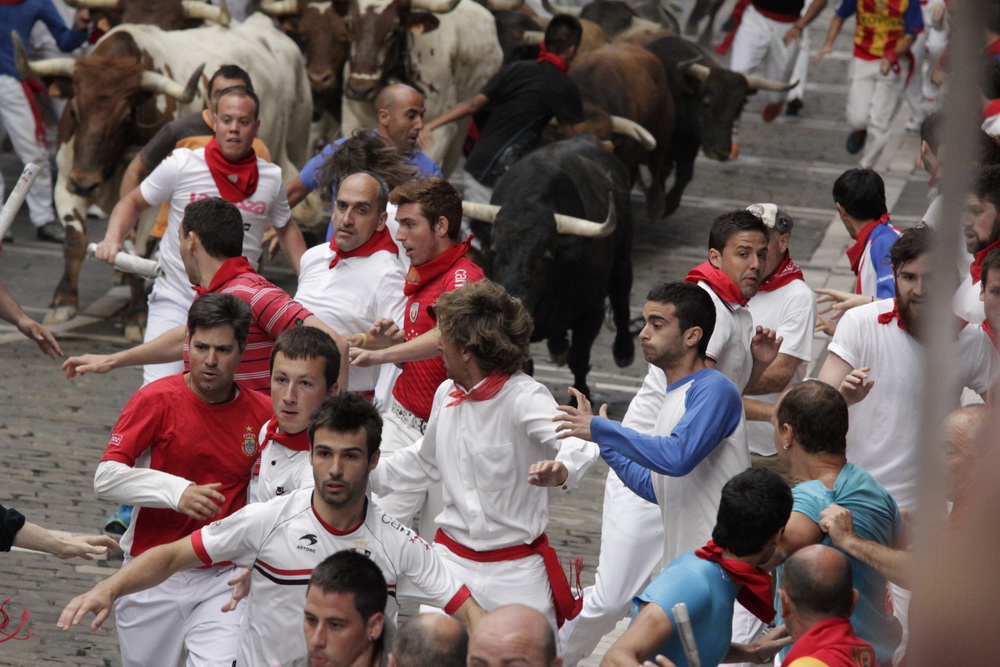by Tim Pinks
(This was written just before fiesta)
Meanwhile…
Well… we’re nearly there, aren’t we? For those of us lucky enough and if we actually make it, the long wait is over, July is upon us and the next and last step on the Escalera will find us submerged deep in fiesta. It’s the exact opposite of the “Pobre-De-Mi.” It’s the “Oh-Lucky-Us.” This months San Ferscribblings start, as its the 25th anniversary, with something about one of the classic runs of recent decades, ends with the usual video clip I like to put in, and includes, for those that remember from a wee while back, the thing about a lion on the streets of Pamplona. Oh yes, only in Pamplona …
Meanwhile, I’ve said it before, and I’ll say it again…San Fermin, you couldn’t bloody script it!
OF BULLS, BLOOD, AND THE LION THING.
A Brief Dissection of a Bull Run
On the early morning of Tuesday July 12th, 1988, as dawn arrived and the sun slowly made its appearance, several thousand people made their way in various states of sobriety or drunkenness, cleanliness or all night party filth towards the streets that would host that morning’s encierro. Some bull runs become famous because, sadly, someone loses their life and the news goes world wide and that particular encierro becomes infamous history.
Other bull runs just develop their own legend due to whatever extraordinary events happen on the day.
What none of us knew that morning was that this run, the 6th of the fiesta, would also go down in fiesta history, as one of the longest, most dangerous and phenomenal of modern times. And yet know one died, thankfully…but it was a close run thing.
The weather that morning was dry, but with the usual chill in the air, so there was nothing untoward happening. I do remember that post-run, even at around 11 o’clock, it still hadn’t warmed up too much, (or at least I hadn’t), although the sun had yet to reach us where we were, having our post run legumbas on the terrace of Bar Txoko.
A scene from the madness of that day.
So there is no real reason as to what happened that morning. As mentioned, it hadn’t rained so that wasn’t a factor, (in the days when there were cobbles everywhere, not to mention the pavements…and no anti-slip sauce to put down on La Curva…rain made things even more interesting than usual), so I guess what happened was just one of those things. The journalist writing his report in the old Navarra Hoy newspaper began his piece with, “It’s a bit complicated to describe yesterday’s encierro.”
Now that’s not a bad start for a description of a bull run, and nicely understated…a journalist struggling for words! Not because nothing happened of course, but quite the reverse…there was enough in that one run to fill an entire fiesta’s runnings. So, its 8 o’clock and the streets are packed and the rocket explodes and the gates to the corral are opened and out charge six fighting bulls mixed in with some steers and the rest of the herd. One of the great, iconic and bloodiest bull runs ever was about to unfold. This is what happened next.
Santo Domingo was run pretty much as usual with one bull, the chestnut coloured Cantarito, running ahead of the rest, causing few problems except for rolling over a couple of people running slower than it was (as the paper put it), and keeping the lead. Just behind him at the end of Santo Domingo, however, one of his brothers, Relojero, hooked his horn and completely flipped a guy off his feet and over onto his head and shoulders, at 47 seconds into the run, and continued to try and get him and others as he drove his horns into the crowd against the wall. This was the start of Relojero’s own distinctive and dangerous run, which included twice running back down Santo Domingo to the corral doors from whence he’d come. He would blood his horns that morning.
More carnage from the run.
Meanwhile the rest of the animals turned into the sunlit Plaza Constitorial and the Town Hall, and by Mercaderes that lone brown bull was still in the lead, the previously mentioned chestnut Cantarito, who made the sharp right angle of La Curva without any problems. He actually took a beautiful running line, the sort experienced runners always try and go for, and continued up to Telefonos with a dangerous but clean run. Then…well, things began to get messy. No wonder the reporter didn’t know where to start.
The first mini headline at the beginning of the report said, “Each bull made his own run, creating a climate of confusion and danger during almost eight minutes of the encierro.” The main headline on the inside pages read: “The bulls of Cebada Gago bring blood to Pamplona .” They certainly did that.
I can’t describe it better than that un-named journalist did (and I can’t find his name in the report), so I’m just going to borrow from the following day’s newspaper report, but only the main bits though, otherwise we’ll be here till the cows come home. It’s a very tricky run to describe chronologically, because there weren’t so many cameras in those days, and things were happening all over the place, but the real drama began with Relojero, and his journey back to the corrals. He returned twice to the corral gates from whence he’d just left a couple of minutes before, then he turned around and it was on one of his runs back uphill, finally going in the right direction, that things began to get bloody.
Many of us know about the dangers of the “doorway run”, but here’s the window one…
On the left as you run up were four guys hanging on in a barred window recess…and one of them stupidly cited the bull (he was the highest up , and hence safest of all of them), and so the bull went for them. Amazingly not too much damage was done. But just a little further on, by the barriers blocking off the market place, another runner was not to be so lucky. Relojero suddenly changed direction and went towards the barrier, violently charging into the 42 year old Pamplonican, Arturo Bueno Echarri, and gored him while lifting him in the air and dropping him back on the ground, before goring him twice more while slamming him hard back against the wooden planking and leaving him be, crumpled, inert, and unconscious, and very seriously hurt. Bueno Echarri had a 20 cm. horn wound in his chest, another in his neck, and the biggest was a nearly 50cm goring from around his knee to his groin. He was attended to pretty immediately by the Red Cross and rushed to hospital.
Relojero” and Arturo Bueno
Meanwhile, further up the road…the aptly named bull “Doloroso,” (meaning painful, grievous), a black beast weighing 510 kilos had lost contact with the herd when he turned into Estafeta from Mercaderes. He was now lost, and his first intention was to run back from where he’d come from, but he was lead bit by bit by runners a little way into the Estafeta, which is where he came across one of the Riley twins.
John and James Riley had been running for quite a few years and knew what they were doing. To quote Hal Jennings about them, “The Riley’s were quick with absolutely no fear.” But that doesn’t ever mean you’re immune to the painful pleasures of the bull run. James Riley, wearing a white top, tripped over on the edge of the pavement that Estafeta had in those days, and Doloroso was quickly onto him. A fight then began between man and bull, with James, thrown along the ground and under the hooves of a by now mightily pissed off beast, desperately trying to fend off the bull and protect himself by attempting to hold on to its horns, a struggle that lasted for several seconds…but which I bet feels like several minutes when it’s you on the receiving end.
His twin brother John, wearing a red top, saw his brother in deep trouble and ran back and literally grabbed the bull by the horns and managed to get it away from his brother and up Estafeta and so get his twin out of danger, but dislocating his shoulder, I believe, in the process.
Another shot from Doloroso´s run
“Doloroso”, and a runner as still as a mannequin. Meanwhile…all sorts of things were happening everywhere else. Remember Relojero? Having returned twice to the corral gates, he eventually made it to the ring, but not before joining his brother Doloroso, yup him again, in Telefonos, where the two of them (this by now towards the end of the nearly 8 minute encierro), caught two runners at the same time as the rest of the herd, stragglers and sweepers caught up with them, and sandwiched those two runners between their horns and lifted them up before dumping them on the ground.
Phew! There is more, so much more…but why not just watch the video? It appears at the end of this piece. If I have got any part of this wrong then you have my apologies, but so much happened that it is hard to put everything in the correct order…but that just sums up the carnage and chaos of that most infamous run from 1988.
Oh, and I just want to name all the bulls, as every single one hurt someone that day, and we can at least give them the respect of remembering them…as we can some of those who were injured too. Those bovine brothers in horns were: Andarin 573 kilos, Doloroso 510 kilos, Relojero 545 kilos, Estudiante 475 kilos, Cantarito 605 kilos, and finally…Doloroso II, 580 kilos. Yup there were two Doloroso’s…too painful and grievous! Sorry, I just had to…
The New Zealander Ian Gordon and his duel with Doloroso.
The New Zealander Ian Gordon and his duel with Doloroso.
Amongst the victims were the previously mentioned Arturo Bueno, with 3 separate gorings by Relojero, a Kiwi called Ian Gordon gored in the cheek at the beginning of Estafeta by Doloroso, after a struggle in a doorway, a 23 year old Pamplonican called Felix Gonzalez Zubira with two separate wounds of 10 and 8 cm respectively, but I can’t find out from which bull.
Fransisco Garcia Gonzalez, an 18 year old from Galicia who had two 15cm wounds, while another 18 year old from Pamplona , Mikel Zabalza Azcona had two superficial horn wounds to his knee. The least hurt by a horn, (hurt being relative here, I think!), was Jesus Irigoyen San Martin, with a cheek wound. That’s on the face, I think…
Apart from the 6 with horn wounds, another 26 were injured, with 14 of them having to go to hospital or clinics. Again, all the bulls involved in the run that day managed to hurt somebody, to a greater or lesser degree. Wow…
THE LION THING
You’d expect, as you wander around the streets of Pamplona, to come into contact with the occasional dog or cat, or even a bull, if you’re really lost. But what if, as you were minding your own business, or perhaps out with your wife and children, you suddenly came across…a lion. You would then, I no doubt wonder, after one of those “what the ****” moments, be rather surprised. Perturbed even. Although as the town’s crest has a lion on it, maybe not…
This however, is what happened to a great many people in Pamplona on the evening of July 10th, 1982. For those of you who remember where the funfair used to be, or know where the new bus station is now, well, that was where the circus was, too. El Pais the next day said in an article that the people were “asombrados y temerosos”. I think you can put in your own meanings there…Just imagine, for a minute. It was summertime, early in the evening, on a Saturday by the funfair and the circus… at promenade time…and during fiesta. It was heaving. And a lion shows up. Well, you don’t need any of today’s instant mobile type footage to imagine the scenes of horror and hysteria on the street.
El País. 10 de julio de 1982
In the true meaning of the word, pandemonium followed, and a tidal wave of people scattered in every direction, and, no doubt, a tsunami of terror and rumour flooded the area. But as so often happens in this magical town when things should go from bad to worse…it didn’t. The lion wandered around for a bit, and then headed towards Julian Gayarre Street, (named after the famous Navarran and Basque opera singer, who died in 1890), and at number 10 slunk into a garage where he decided to stay and rest, no doubt wondering what the big fuss was about.
Well, around about 9 in the evening, a couple of trainers and others from the circus showed up, (one hopes, after being told that one of their lions was missing, that in true local style they decided to finish their pintxos and vinos first), and managed to coax the animal into a wheeled cage, and walk with it the short distance back to the circus, with no harm done. San Fermin…you couldn’t ruddy script it! Where have I read that before…
It’s brief freedom over, Pamplona ‘s health and safety brigade (note the man with his hand on the bars!) transport the lion back to the circus.
And so, for those of you who are lucky enough to be heading towards Navarra for the Fiesta of San Fermin this July and the world’s greatest party, remember…anything, absolutely anything, can happen in Pamplona . But also, as Ratty from “The Wind in the Willows” might have said, had he ever gone: “There is nothing – absolutely nothing – half so much worth doing as messing about in fiesta.” Viva that! But remember…messing about with bulls can hurt! So beware, and although this clip isn’t great quality, it’s not for the squeamish. And if you’re new to the run, remember one rule above all else…if you fall down, stay down. The run is fun…but at it’s deadliest, it will kill.
And now, after nearly a year of waiting…Ya falta nada…VIVA SAN FERMIN! GORA!




